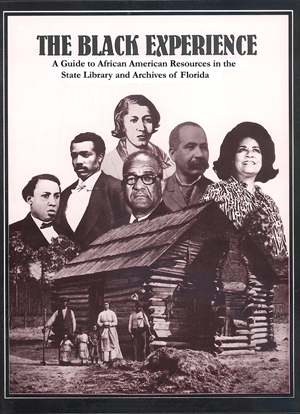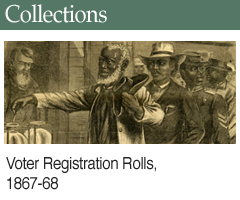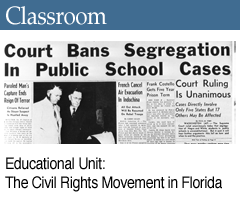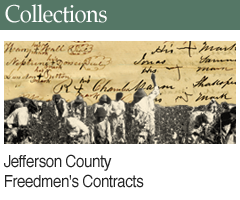Guide to African American Resources in the State Library and Archives of Florida

National Archives/Federal Records
National Archives Microfilm Publications
(Record
Group 1025)
The State Archives of Florida collects copies of various microfilm publications produced by the National Archives and Records Administration from original records in their collection pertaining to Florida history.
Letters Sent by the Department of Florida and Successor Commands, 1861-1869,
2 microfilm reels (35 mm.)
S 1300
This microfilm publication contains seven volumes of letters sent by the Department of Florida and its successor commands from April 1861 to January 1869. The letters and reports were dispatched by the commanding officers and their adjutants from department and district headquarters.
The kinds of problems facing the Department of Florida and its successor commands are clear from the letters reproduced in this publication. The letters reveal the vacuum in military authority experienced in Florida at the commencement of the Civil War, as the commanding officer of Union forces in the state attempted to deal with the suspension of habeas corpus, the premature confiscation of slave property, and the suspension of state courts whose loyalty to the Union was in doubt. The problems of communication delays, discipline, and duties are clearly outlined in the letters throughout the war years. The reports describe the movements of the enemy and provide intelligence gleaned from behind Confederate lines. Battle action reports of the few skirmishes are included in the letters to higher authority.
After the war a particularly virulent outbreak of fever, which plagued the whole state for a year or more, took up much of the time of the officer in command. Matters relating to protecting the civil and political rights of African Americans and Union sympathizers were prominent. The letters also discuss the enforcement of labor contracts, the location and establishment of African Americans on their own property (even the establishment of a few colonies, such as at New Smyrna, made up of African Americans from out of state), the prevention of schemes to kidnap and smuggle African Americans to Cuba, the status of slaves belonging to the few remaining Seminoles in the state, and the very sensitive matter of the use of black troops against white civilians.
Some overlapping of dates between volumes 6 and 7 exists, but there is no duplication of letters. A few of the letters bear nonconsecutive identifying numbers.
A name index to each volume, keyed to page numbers, has been filmed before the appropriate volume of letters sent.
Freedman's Savings and Trust Company Depositor's Signature Registers, 1865-1874,
27 microfilm reels (35 mm.)
S 1775
The Freedman's Savings and Trust Company was established in New York City in 1865 by a group of philanthropists and businessmen led by Congressional minister John Alvord. Their purpose was to provide former slaves and their descendants, and particularly the many African American Civil War veterans receiving back pay and enlistment bounty payments, with a secure banking institution in which their savings could be protected.
A bill to incorporate the bank was passed by Congress and, on March 3, 1865, signed into law by President Abraham Lincoln. Between 1865 and 1871, the bank opened 37 branch offices in 17 states and the District of Columbia, patronized by about 70,000 depositors.
A combination of management problems, fraud, and fallout from the Panic of 1873 brought the bank close to collapse, and it closed on June 29, 1874. Misled into believing that their deposits were protected by the federal government, depositors lost their savings, and only about half were eventually partially compensated for their losses.
This series consists of microfilm copies of 55 volumes containing signatures of and personal information about thousands of depositors who maintained accounts in 29 branch offices of the Freedman's Savings and Trust Company. The bank collected detailed information about depositors and their heirs in order to protect their interests in the event of the depositor's death.
The series includes registers for the Tallahassee, Florida branch office from 1866-1872 (Roll 5). Although depositor information varies from branch to branch, the registers generally provide the name of depositor; account number; date of application; place of birth; place brought up; residence; age; complexion; name of employer or occupation; names of spouse, children, father, mother, brothers, and sisters; remarks; and provide name of former owner or mistress and name of plantation. In addition, copies of death certificates were attached to some entries.
Federal Census Slave Schedules, 1850-1860, 173 microfilm reels (35mm.)
S 1776
Beginning in 1790, the federal government conducted a census every ten years in all of the states. Slave schedules were conducted in 1850 and 1860.
Slave schedules from the federal census conducted in 1850 and 1860 contain the names of the owners, number of slaves, age, sex and color of the slaves. Occasionally the census would include individual names of slaves. The series includes slave schedules for Alabama, Arkansas, District of Columbia (1860 only), Florida, Georgia, Kentucky, Louisiana, Maryland, Mississippi, Missouri, New Jersey (1850), North Carolina, South Carolina, Tennessee, Texas, and Virginia.
FEDERAL CENSUS RECORDS
Beginning in 1790, the federal government conducted a census every ten years in all of the states. Territorial censuses were conducted in areas not yet admitted to the Union. They contain the same information as the state censuses. (See also series S 1776 under National Archives Microfilm Publications above.)
The purpose of the federal census is to enumerate the entire population of the country every ten years by county jurisdiction. The first six federal censuses, those from 1790 to 1840, were overseen by federal marshals. The first Census Office began operation in Washington in 1850. This was only temporary as the Office was disbanded after each count. The Census Office became permanent in 1902.
The first six censuses were similar in content, naming only the heads of families. All other people were noted only by tally marks in categories for age, sex, race, and slavery, except that the Constitution excluded from the census all Indians not taxed. The later federal censuses included a variety of different schedules. The 1850 and 1860 censuses contained free population, slave population, mortality, agriculture, and industry schedules. The 1870 and 1880 counts included schedules for population, mortality, agriculture, and industry. Less than one percent of the results of the 1890 census remain after the 1921 fire in Washington. The 1900 census has separate schedules for population, mortality, agriculture, and manufactures. The census of 1910 had different schedules for population, agriculture, and manufactures.
The federal census was first compiled in Florida in 1830. It has served as Florida's census record since 1950 due to the abolishment of the state census in 1949 (Senate Joint Resolution #46, 1949).
Federal Census of Florida, 1850, 4 cubic feet
S 1200
This series contains part of the 1850 federal census of Florida. These records include four schedules: agriculture, industry, mortality, and social statistics. The population schedule is not included in the series. The Mortality schedule names all the persons who died during the year while residing with their family. It also provides the age, sex, race, and marital status of each individual, the place and date of birth, occupation, cause of death, length of illness, and the month of death. The status of blacks as slaves or freed persons is noted.
Federal Census of Florida, 1860, 4 cubic feet
S 1201
This series contains part of the 1860 federal census of Florida. These records include four schedules: agriculture, industry, mortality, and social statistics. The population schedule is not included in the series. The mortality schedule lists the names of persons who died during the year at their family residence. It records the age, sex, race, and marital status of each person, place of birth, occupation, month of death, cause of death, and number of days ill. Blacks are noted as slaves or freed persons.
Federal Census of Florida, 1870, 5 cubic feet
S 1202
This series contains part of the 1870 federal census of Florida. These records include four schedules: agriculture, industry, mortality, and social statistics. The population schedule is not included in the series. The mortality schedule names persons who died during the year while living at their family residence. It records each individual's place of dwelling, age, sex, race, occupation, real estate holdings, place of birth, parentage, education, citizenship, and any mental or physical handicaps. It also notes if the person was male, over 21, and had the right to vote.
Federal Census of Florida, 1880, 5 volumes, 5 cubic feet
S 548
This series contains the 1880 federal census of Florida. The compiled information was gathered for the year ending May 31, 1880. It is broken down into five schedules: population; agriculture; defective, dependent, and delinquent classes; manufactures; and mortality.
The Population schedule includes the name and age of individual residents, their street and house number, relationship to the head of the family, month of birth if born within the year, sex, race, birthplace, occupation, marital status, whether married within the year, whether temporarily or permanently disabled, whether crippled, maimed, or deformed, number of months unemployed during census year, whether deaf, dumb, blind, or insane, whether able to read and write, whether attended school within the year, birthplaces of mother and father, and whether father and mother of foreign birth.
The Mortality schedule names all persons residing with their families who died during the year preceding June 1, 1880. Information on each individual includes age, sex, race, marital status, parents' countries of origin, place of birth, occupation, month in which they died, cause of death, length of county residency, where disease was contracted, and name of attending physician.
United States. Army. Dept. of the South.
Census of the District of Florida, 1864-1865, 0.50 cubic foot
S 1489
As an administrative measure, the United States Army divided the nation into departments to control the military forces within certain geographic boundaries. Those areas that were captured while in rebellion were governed by military officers of the department rather than by civilian officials. The departments were named to reflect the geographic areas that they administered. In 1864 the Department of the South was headquartered in the Hilton Head/Beaufort area of South Carolina. It included the Districts of Florida and Georgia as well as the District of South Carolina. The Union forces that comprised the District of Florida occupied the major population centers of the state.
This series consists of portions of censuses conducted in the District of Florida during 1864 and 1865, surveying the residents of Jacksonville, St. Augustine, the St. Johns River area, Amelia Island, and Fernandina. The 1864 census was conducted in the Jacksonville, St. Augustine, and St. Johns area. It is divided by race and enumerates all persons by name, status of citizenship, place of birth, and whether the enumerated was a free person of color or "contraband". The status of "contraband" was applied to those persons who had been held in bondage but were now free or within the Union lines. Those persons enumerated as contraband also had the name of their former slave master recorded.
The 1865 census is of the Amelia Island area. It is limited to "colored" and notes relationships among the enumerated, ages, sex, former slave masters, where the person was held in bondage, and the enumerated's occupation. Wives of men in the Union Army are also noted.

 Listen: The Bluegrass & Old-Time Program
Listen: The Bluegrass & Old-Time Program





